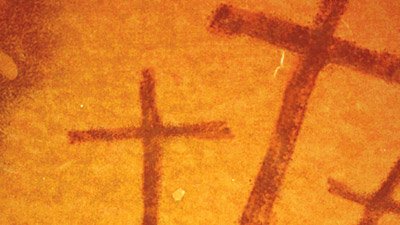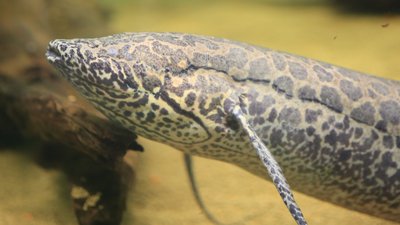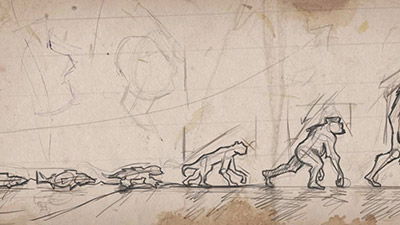
From Water to Land: The Evolutionary Transition Revealed
The supposed missing link Tiktaalik is back in the news, rearing its ugly “evolutionary” head on the supposed transitional element of a mobile neck.
News Source
A new study published in Nature takes a look at skeletal features other than the fish’s fins, which have previously been the centerpiece for claims that it was evolving into a land dweller. Specifically, the new study looks at the specimen’s internal head skeleton.
It’s perhaps no surprise that this latest study turned up more overlapping features.
According to the paleontologists who discovered Tiktaalik, the fossil has just the right combination of features that overlap between fish and primordial tetrapod—the perfect missing link, as it were. Of course, since evolutionists need to find missing links to corroborate Darwinism, it’s perhaps no surprise that this latest study turned up more overlapping features.
Jason Downs, a scientist at the Academy of Natural Sciences, was lead author of the new study. According to Downs, “the braincase, palate and gill arches of Tiktaalik help reveal the pattern of evolutionary change in this part of the skeleton.”
The first such patterns listed by the news release are “[t]rends in head shape include a flattening of the skull and a lengthening of the snout.” Yet consider, for instance, the variation in the head shapes of the many, many types of fish and aquatic creatures. To describe Tiktaalik’s head as part of a trend is 100% evolutionary interpretation.
Reuters reports, “It was a large aquatic predator, measuring up to 9 feet long, with sharp teeth and a flattened head like a crocodile and unlike primitive fish.” And that’s exactly what we can actually know from the fossils (except the predator bit, which the fossil only hints at with its sharp teeth). Anything more is speculation based on the observer’s underlying presuppositions.
The interactions between other parts of the head skeleton are also described as “changing,” something clearly impossible with fossilized skeletons. The change isn’t in the fossil record; it’s occurring in the minds of those who already believe in evolution. And even if there’s a clear evolutionary explanation for why a particular structure would be advantageous, that doesn’t mean it evolved.
So when the University of Chicago’s Neil Shubin (one of the codiscoverers of Tiktaalik) claims, “Tiktaalik neatly fills this morphological gap, and helps to resolve the timing of this complex transition,” it is only because he presupposes that morphological similarities indicate where a creature belongs in an evolutionary lineage. This is the same logic that says a middle-sized horse must be the intermediary between a small horse and a large horse, when in fact we see all three alive today. But when a creature is only known from the fossil record, evolutionists are free to speculate about its role in the evolutionary process.
Evolutionists are free to speculate about its role in the evolutionary process.
Don’t believe us? We’ve heard the story before, with coelacanths, a fish once known only from the fossil record. The lobed fins on the fossil specimens fueled evolutionary claims that it walked on the ocean floor and evolved into a land-walking tetrapod.
Imagine evolutionists’ surprise when, in 1938, a live coelacanth was found swimming—not walking!—in the ocean off the African coast. Apparently the coelacanth was unaware that it was supposed to have been a transitional form extinct for 65 million years! More have been found in recent years, and the lobed fins are clearly used just to help the fish swim.
Besides, evolutionists still haven’t shown they can explain how random genetic mistakes (mutations) can account for the genetic information to create working, useful anatomical features.
So while National Geographic News reports that Downs said, “What’s most surprising about Tiktaalik is that, really, it’s not surprising at all” and added that “Tiktaalik fits so neatly into the fossil record,” we’d say it actually fits so well because evolutionists have interpreted the sparse Tiktaalik fossils into the evolutionary mold they already had in mind.
Further Reading
- Tiktaalik and the Fishy Story of Walking Fish
- Tiktaalik and the Fishy Story of Walking Fish, Part 2
- Fossils—Do They Get More Complex?
- Yet Another “Missing Link” Fails to Qualify
For More Information: Get Answers
Remember, if you see a news story that might merit some attention, let us know about it! (Note: if the story originates from the Associated Press, FOX News, MSNBC, the New York Times, or another major national media outlet, we will most likely have already heard about it.) And thanks to all of our readers who have submitted great news tips to us. If you didn’t catch all the latest News to Know, why not take a look to see what you’ve missed?
(Please note that links will take you directly to the source. Answers in Genesis is not responsible for content on the websites to which we refer. For more information, please see our Privacy Policy.)
Recommended Resources

Answers in Genesis is an apologetics ministry, dedicated to helping Christians defend their faith and proclaim the good news of Jesus Christ.
- Customer Service 800.778.3390
- © 2024 Answers in Genesis






